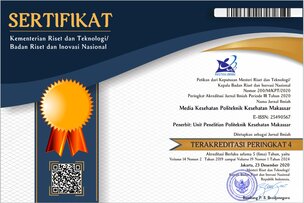Potential Test of Acceptability, Elasticity, Nutritional Content and Cyanide Acid: Wet Noodles Cassava Leaves
Abstract
Abstract
Noodles is one of the foods favored by the people of Indonesia and economical and practical, so it is necessary to processing alternatives that qualify nutritionally with the addition of fiber from cassava leaves. This study aims to find out the acceptableness, elasticity, iron content, protein, fiber and hydrogen cyanide. This type of research is an experiment that is the manufacture of noodles using the addition of cassava leaves (15%, 30% and 50%) then conducted an analysis of protein, iron, fiber using gravimetry, analysis of hydrogen cyanide levels using volumetri with tools - ingredients are scales, sieves, molds, measuring cups, filters, wheat flour, egg whites, garlic, cassava leaves and salt. The results of the research from the preferred hedonic aspect are a concentration of 15%. Noodles with cassava leaves concentration of 15% have the elasticity value closest to wet noodles without cassava leaves which is 3.3 cm with medium category, the highest iron content with cassava leaves concentration of 50% as much as 0.5 mg / 100 grams, the highest fiber content as much as 9.67 grams per 100 grams, the highest HCN content as much as 15.7 mg per 100 grams, the highest protein content of noodles with cassava leaves concentration of 15% obtained as much as 8,222 grams / 100 grams. In conclusion, preferred acceptableness and elasticity as well as the highest protein content with 15% cassava leaves, the highest iron, fiber and HCN levels with a concentration of 50%.
Keywords
Full Text:
PDF (Full Text)References
Abraham, K., Buhrke, T., & Lampen, A. (2016). Bioavailability of cyanide after consumption of a single meal of foods containing high levels of cyanogenic glycosides: A crossover study in humans. Archives of Toxicology., 90(3), 559–18. Crossref PubMed. https://doi.org/10.1007/s00204-015-1479-8
Adugna, B. (2019). Review on nutritional value of cassava for use as a staple food. Science Journal of Analytical Chemistry, 7(4), 83–91, Crossref. https://doi.org/10.11648/j.sjac.20190704.12
Alamu E. A., Chileshe P., Bukola O., Marymolola O., Olanike A., David C., and Busie M. D. (2021). Evaluation of nutritional properties, and consumer preferences of legume-fortified cassava leaves for low-income households in Zambia, Cogent Food & Agriculture, vol. 7 (1). https://doi.org/10.1080/23311932.2021.1885796
Alamu, E. O., Ntawuruhunga, P., Chibwe, T., Mukuka, I., & Chiona, M. (2019a). Evaluation of cassava processing and utilization at household level in Zambia. Food Security, 11(1), 141–150. Crossref. https://doi.org/10.1007/s12571-018-0875-3
Alamu, E. O., Ntawuruhunga, P., Chileshe, P., Olaniyan, B., Mukuka, I., & Maziya D. B. (2019b). Nutritional quality of fritters produced from fresh cassava roots, high-quality Cassava and soy flour blends, and consumer preferences. Cogent Food and Agriculture, 5(1), 1677129, Crossref. https://doi.org/10.1080/23311932.2019.1677129
Ambarsari I., Endrasari R. and Oktaningrum G. N. (2017). The effect of cassava and corn flour utilization on the physicochemical characteristics of cassava leaves snack. IOP Conference Series: Earth and Environmental Science. https://doi.org/10.1088/1755-1315/102/1/012046
Anjani K. N., Baharuddin H. & Paulus H. A. (2021). Analysis of Cyanide Contents in Cassava Leaves (Manihot esculenta Crantz) Based on Boiling Time with Formation of Hydrindantin Complex by Using UV-Vis Spectrophotometry. Jurnal Akademika Kimia, pp49-52. doi: 10.22487/j24775185.2021.v10.i1
Astuti, R. D. (2019). Variations of Mixing Moringa Leaf Flour in Noodle Making Reviewed from Physical Properties, Organoleptic Properties and Food Fiber Content. Health Polytechnic of the Ministry of Health Yogyakarta.
Bayata A. (2019). Review on Nutritional Value of Cassava for Use as a Staple Food. Science Journal of Analytical Chemistry 7(4):83. https:// doi.org/10.11648/j.sjac.20190704.12
Boundy‐Mills, K., Karuna, N., Garay, L. A., Lopez, J. M., Yee, C., Hitomi, A., & Jeoh, T. (2019). Conversion of cassava leaf to bioavailable, high‐protein yeast cell biomass. Journal of the Science of Food and Agriculture, 99(6), 3034–3044. Crossref PubMed. https://doi.org/10.1002/jsfa.9517
Cyanogenic, carotenoids and protein composition in leaves and
Cyanogenic, carotenoids and protein composition in leaves and
Cyanogenic, carotenoids and protein composition in leaves and
Cyanogenic, carotenoids and protein composition in leaves and
Cyanogenic, carotenoids and protein composition in leaves and
Cyanogenic, carotenoids and protein composition in leaves and
Cahyanti M. N., Alfiah M. N., Hartini S. (2018). Sorption Isotherm Modelling Of Fermented Cassava Flour by Red Yeast Rice. IOP Conf. Series: Materials Science and Engineering. https:// doi:10.1088/1757-899X/349/1/012038
Diarra S.S., Anand S., (2020). Impact of commercial feed dilution with copra meal or cassava leaf meal and enzyme supplementation on broiler performance. Poultry Science, Vol 99(11): 5867-5873. https://doi.org/10.1016/j.psj.2020.08.028
Estiasih, T., Putri, W. D. R., & Waziiroh, E. (2017). Tubers - Tubers and Their Management (T. U. Press, Ed.). Unfortunate: UB Press.
FAO, 2019. FAOSTAT Database; Food and Agriculture Organization of the United Nations: Rome, Italy, 2019.
Forsythe, L., Posthumus, H., & Martin, A. (2016). A crop of one’s own? Women’s experiences of cassava commercialization in Nigeria and Malawi. Journal of Gender, Agriculture and Food Security, 1(2), 110–128. Crossref
germplasm collection at CIAT, Colombia
germplasm collection at CIAT, Colombia
germplasm collection at CIAT, Colombia
germplasm collection at CIAT, Colombia
germplasm collection at CIAT, Colombia
germplasm collection at CIAT, Colombia
germplasm collection at CIAT, Colombia
Ginting N. (2018). Comparison of isolate dadih with yeast dadih in improving nutrition quality of Cassava Waste (CW). IOP Conf. Series: Earth and Environmental Science. https:// doi :10.1088/1755-1315/141/1/012008
Handayani, V. (2017). Effect ratio of Wheat, Red Spinach and Seaweed to Fe Levels and Organoleptic Characteristics of Wet Noodles. Journal of Chemical Information and Modeling, 53(9), 1689–1699.
Herminiati A., Rahman T., Turmala E. and Fitriany C. G. (2017). Correlation of concentration of modified cassava flour for banana fritter flour using simple linear regression. IOP Conference Series: Earth and Environmental Science. https://doi:10.1088/1755-1315/101/1/012022
Ihemeje A, Uneanya G.C., Odimegwu N.E. and Echefu E.O. (2017). Quality Evaluation of Cassava-Pigeon Pea Composite Flour And The Cookies. Journal of Agriculture and Food Sciences 15(2) pp 43-53. https://dx.doi.org/10.4314/jafs.v15i2.5
Jens L., Sebastian A., Sajid L., and Joachim M. (2020). Potential of Biogas Production from Processing Residues to Reduce Environmental Impacts from Cassava Starch and Crisp Production—A Case Study from Malaysia, Applied Sciences Volume 10 (8). https://doi.org/10.3390/app10082975
Junior, E. N. M., Chisté, R. C., & da Silva P. R. (2019). Oven drying and hot water cooking processes decrease HCN contents of cassava leaves. Food Research International., 119, 517–523. Crossref PubMed. https://doi.org/ 10.1016/j.foodres.2019.01.029
Kemenkes RI. (2017). Tabel Komposisi Makanan di Indonesia. Kementerian Kesehatan
Kemenkes RI. (2018). Riset Kesehatan Dasar, Badan Penelitian dan Pengembangan Kesehatan.
Kemenkes RI. (2019). Angka Kecukupan Gizi. Jakarta: Badan Penelitian dan Pengembangan Kesehatan Kementerian Kesehatan.
Maria A. O., Monica P., Thierry T., Julien R., John B., Jorge L. L., Luis F. L., Sandra S., Hernan C., Dominique D. & Luis A. B. L.-L. (2021). Cyanogenic, carotenoids and protein composition in leaves and roots across seven diverse population found in the world cassava germplasm collection at CIAT, Colombia. International Journal of Food Science and Technology, 56: 1343-1353.
https://doi.org/10.1111/ijfs.14888
Megersa D. (2019). Nutritional And Hydrogen Cyanide Compositions And Consumers Preference In Cassava Varieties Grown In East Hararghe Zone Of Oromia, Ethiopia. International Journal of Technology Research, Vol 8(2):14-19.
Natalie K.M. and Mingan C. (2016). Cassava: Nutrient composition and nutritive value in poultry diets, Review Article. Animal Nutrition vol 2 (4): 2016 , 253-261. https://doi.org/10.1016/j.aninu.2016.08.010
Peprah B. B., Elizabeth Y. P., Obed A. H. , Angeline van B., Matilda S. A. and Maryke T. L. (2020). Proximate Composition, Cyanide Content, and Carotenoid Retention after Boiling of Provitamin A-Rich Cassava Grown in Ghana. Foods, MDPI 1-13. https:// doi.org/10.3390/foods9121800
Oluwatoyin A., Sajid L., Adebayo A. and Joachim M. (2018). Comparing Characteristics of Root, Flour and Starch of Biofortified Yellow-Flesh and White-Flesh Cassava Variants, and Sustainability Considerations: A Review. Sustainability, MDPI 10, 3089. https://doi.org/10.3390/su10093089
Oresegun A., O. A. Fagbenro P. I. & Edah B., Fatih Y. (2016). Nutritional and anti-nutritional composition of cassava leaf protein concentrate from six cassava varieties for use in aqua feed. Cogent Food & Agriculture, Volume 2 (1). https://doi.org/10.1080/23311932.2016.1147323
Piengtawan T., Supajit S., Nattaya S., Peng W., Huaxin H., Kanokporn T. (2020). Effects of cassava variety and growth location on starch fine structure and physicochemical properties. Food Hydrocolloids, Vol 108. https://doi.org/10.1016/j.foodhyd.2020.106074
Purnamasari, D. U. (2018). Nutrition and Health Guide for School Children (E. Risanto, Ed.). Yogyakarta: ANDI.
roots across seven diverse population found in the world cassava
roots across seven diverse population found in the world cassava
roots across seven diverse population found in the world cassava
roots across seven diverse population found in the world cassava
roots across seven diverse population found in the world cassava
roots across seven diverse population found in the world cassava
roots across seven diverse population found in the world cassava
Raden C. E. A, Taufik R., Ainia H., Nurhaidar R., Rohmah L. (2017). Characteristics of Chemical and Functional Properties of Modified Cassava Flour (Manihot esculenta) by Autoclaving Cooling Cycles Method. IOP Conference Series: Earth and Environmental Science. https://doi:10.1088/1755-1315/101/1/012023
Sajid L., Sonja Z., Ziba B., and Joachim M. (2019). Detoxification of Cassava Leaves by Thermal, Sodium Bicarbonate, Enzymatic, and Ultrasonic Treatments. Journal of Food Science Vol. 84 (7). https://doi: 10.1111/1750-3841.14658
Saragih B., Febi K., Pradita, Krishna P. C., Aswita E. (2020). Nutritional Value, Antioxidants Activity, Sensori Properties, and Glycemic Index of Cokies with Addition of Cassava (Manihot utilissima) Leaf Flour. J. Nutr Sci Vitaminol. https://doi: 10.3177/jnsv.66.S162
Thidarat P., Shima J., Fazilah A., Syahariza Z. A., Ziba B., Sajid L., Joachim M. (2019). Improving Nutrition, Physicochemical and Antioxidant Properties of Rice Noodles with Fiber and Protein-rich Fractions Derived from Cassava Leaves. Journal of Food and Nutrition Research, 2019, Vol. 7 (4); 325-332. https//doi:10.12691/jfnr-7-4-10
DOI: https://doi.org/10.32382/medkes.v16i2.2558
Refbacks
- There are currently no refbacks.
Copyright (c) 2021 Dr. Rudy Hartono, SKM, M.Kes

This work is licensed under a Creative Commons Attribution-NonCommercial-ShareAlike 4.0 International License.
Published By : Poltekkes Kemenkes Makassar
Office : Jl. Wijaya Kusuma Raya No. 46 Banta-Bantaeng, Kota Makassar, Sulawesi Selatan, Indonesia
Email : mediakesehatan@poltekkes-mks.ac.id
Media Kesehatan indexed by :
Protected By  |  |

This work is licensed under a Creative Commons Attribution-NonCommercial-ShareAlike 4.0 International License.





